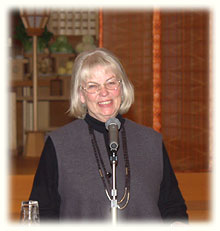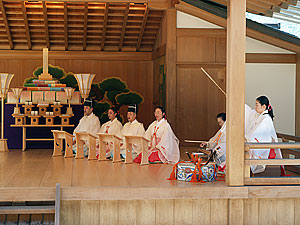
By Coeleen Kiebert
The speech for people of Oomoto on Setsubun at Choseiden Sanctuary.(February 3, 2003)

Good afternoon.
It’s a pleasure to be here at Oomoto once again. Several times I have visited during Cherry blossom season and Most recently, for your spectatcular fall, but I never dreamed that I could Be here in the winter for Setsubun… and, in addition with my daughter, Cathleen.
Cathleen is presently a doctoral candidate at Columbia University in New York City, Doing her Ph. D. dissertation in Art Education, so you can understand her special interest.
We both thank you very much for this special opportunity I have been asked to speak about How I First Began To Be Interested In Eastern, Japanese Culture.
In the early 1950's I was a young University student who knew nothing of Oriental cultures.
W. W. II was barely behind us and Japan was a distant mysterious nation with which I didn't believe I would ever be involved.
I was reluctantly studying ceramics because it was a requirement necessary to complete my University degree in Art Education. At the time, the field of ceramics in the United States was terribly dull and full of superficial "kitsch". The Industrial Revolution had taken over and everything looked manufactured and very similar. Creativity had been set aside for the need to fulfill demand.
However, fortunately for me, at that time a new Ceramics instructor arrived at the University. His name was Warren MacKenzie and he had just returned from a two year apprenticeship in England with Bernard Leach. He told us of a folk craft movement that had been organized in Japan between Leach and three Japanese potters… Shoji Hamada, Kenkichi Tomimoto and Kenjiro Kawai. He spoke of their endeavors to save the traditional folk crafts of Japan against the onslaught of the Industrial Revolution, as it was threatening to obliterate the hand-made charm and integrity that had developed in ceramics over many centuries.
Studying with Warren and learning of the Japanese sense of naturalness in their pottery with a very human touch and feeling warmed me to the craft. This deeply effected my enthusiasm for what ceramics could become, my sense of a spiritual meaning in the arts, and my teaching. But still, I never dreamed that I would ever set foot in Japan. Until the mid 1970,s. I was visiting Grace Cathedral in San Francisco and the Dean Rodgers, who knew of my interest in art as a spiritual practice, handed me a book by Frederick Franck… "An Encounter With Oomoto".
He told me of a remarkable group of people from Japan that had just visited the Cathedral. They had presented their Shinto rituals, performances and works of art, all as a spiritual offering.
As I read about these people and learned of the teachings of their inspiring founders, I became very excited and believed this was a place that I must visit.
I felt that, as a teacher in the United States, I was no longer alone in my belief that doing one's art form can also be a spiritual practice. There was actually a community of people that lived this philosophy and practiced it.
By the end of the book I knew that I would have to visit Oomoto. Something very important was happening to quicken my spirit in this direction and there was no turning back. A trip to Japan was the obvious next step.
 I visited Oomoto. Masamichi Tanaka was my guide and, in addition to showing me the grounds of Oomoto, he showed me the old climbing kiln back in the corner of the grounds and the precious collection of Onisaburo's scintillating pots. I was enchanted by their brilliant glazes, poetic names and complete uniqueness. I'd never seen anything like them before (nor since).
I visited Oomoto. Masamichi Tanaka was my guide and, in addition to showing me the grounds of Oomoto, he showed me the old climbing kiln back in the corner of the grounds and the precious collection of Onisaburo's scintillating pots. I was enchanted by their brilliant glazes, poetic names and complete uniqueness. I'd never seen anything like them before (nor since).
At the end of the day I asked Tanaka-san if I could come back and attend some classes, and he agreed.
A few years later 1985 I attended the Oomoto School of Traditional Arts Summer Seminar. This experience deepened my understanding of how the practice of art is related to our personal and spiritual growth. Each art form, calligraphy, tea ceremony, Noh dance, budo… all bore into my being.
Because of my experiences in Japan and China, and especially because of the relationship that I have with the people here at Oomoto, I feel as though I have been able to go behind the scenes and see the very origins of the beginning in the art.
This brings me to the desire to express my gratitude for having come upon Oomoto and for being able to bring my family, friends and students here. We are all hungry for what you have to offer and look forward to a future in which we can continue to deepen our friendships, practice our arts together and exchange our common view that peace can be obtained through the arts.
We all create and we are all blessed to know that doing art can become an offering that holds within it the promise of personal peace and perhaps, collectively, even world peace.
Finally, as an American, especially at this time, when the world is in such turmoil under the threat of wars and terrorism, we must not caught up in fears, but instead we must turn our hearts and our lives to meet the challenge of our belief that the practice of art is for the betterment of our selves and can demonstrate to others our faith in the power of art to manifest personal and world peace.
Thank you very much.
New Contents Thu, May 20, 2010
- Oomoto participates in Sant’Egidio conference : Dialogue among religions and cultures : On divided island nation of Cyprus By Bill Roberts
- Photo Album : Portraits of three branches: Shoko, Tanegashima and Aomori By Bill Roberts
- Oomoto FAQ
- A Letter from Oomoto : Of mountains and myths By Bill Roberts
- Polyglot poem festival The Utamasturi is going international — what’s next? By Bill Roberts
- Ethics education program captures the spirit of Bankyo Dokon By Bill Roberts
- A Letter from Oomoto : A year’s worth of adventure in a summer of branch visits By Bill Roberts
- In Kumamoto, it’s all about water – and fire By Bill Roberts
- A speech by Nevada Taylor at the Kii Branch in Wakayama Prefecture on April 13, 2008.:An Encounter With Oomoto Through Aikido
- Utamatsuri, Poem Festival, in Tokyo(on April 17, 2008)
- A speech by Neil Ryan Walsh at the Kobe branch on Mar. 9th, 2008.:Planting the Seeds of the Soul
- Meeting with the Fifth Spiritual Leader of Oomoto, Madame Kurenai Deguchi by Neil Ryan Walsh
- A speech by Neil Ryan Walsh at the Nagoya branch on Feb. 17th, 2008.:The Japanese Arts beyond National Boundaries
- To the Oomoto branch in Nagoya: City of Eel and Toyota by Neil Ryan Walsh
- A Speech by Nissim Ben Shitrit, Ambassador of Israel on the occasion of the Oomoto Setsubun Grand Festival in Ayabe February 3rd, 2008 : Japan and Israel : Two Lands Balancing the Needs of Traditional Culture and Modern Life. r
- A permanent memorial to Onisaburo (A Speech at the Autumn Grand Festival , November 6, 2007 : )By James Parks Morton, Founder and Chair, Emeritus of The Interfaith Center of New York
- Israel, Palestine and the Power of Poetry(Oomoto believes small efforts can have lasting ripple effects on people and peace)By Bill Roberts
- “Something Great”(This genetics pioneer, a friend of Oomoto, offers a clue to the mystery of life)By Bill Roberts
- Kamishima Cleanup (Harima branch members regularly visit this sacred island to keep the shrine tidy)By Bill Roberts
- Kyotaro Deguchi was one of six recipients of the 2007 James Parks Morton Interfaith Award
What is Oomoto?
- What is Oomoto?
- Spirtual Centers
- Founders and Spiritual Leaders
- History
- Organization and activities
- Teachings and scriptures
- Art Works of Founders and Leaders
Opinions[Archive]
- Statement of regret for the outbreak of war against Iraq (March 20,2003)
- Jinrui Aizenkai dispatched the "Urgent Appeal for a World (Global) Crisis" on March 14.
Grappling with Bioethics[Archive]
- Oomoto’s support for abolishing the death penalty (12, June 2003)
- The Oomoto Foundation protests any birth of a human clone baby. (5, January 2003)
- OOMOTO'S VIEW REGARDING JAPAN’S PERMITION TO THE RESERCH OF HUMAN EMBRYONIC STEM CELLS (ES cells)(12, June 2000)
Vistor’s Review[Archive]
- A speech by Bill Roberts at the Oomoto branch in Hiroshima after its monthly service on March 18, 2007:Encounters with war and peace
- How Bankyo Dokon changed one life by Linda Macphee
- A speech by Bill Roberts at the Hokuriku (Kanazawa) branch on Dec. 3, 2006:Ritual and myth -an encounter with ‘divine madness’
- A speech by Bill Roberts at the Himeji Cultural Center on Feb. 25, 2007:Mesmerized by the Japanese Arts
- A speech by Bill Roberts at the Kobe branch on Feb. 11th, 2007.:There are just human tears and human joy
- A Speech on the occasion of the Oomoto Setsubun Grand Festival in Ayabe February 3rd, 2007 : Egypt's role in Middle East peace
- Keynote Speech for the 28th World Federation Japanese Religionists Conference for World Peace in Tokyo (at Kokugakuin University, Novermber 29, 2006):Vision for Peace in the Middle East By Dr. Munther S. Dajani, Professor Dean, Faculty of Arts, Al Quds University, Jerusalem
- A speech to the Kyoto branch:Spiritual adventures in researching Oomoto leaders
- A Speech at The Oomoto Foundation on Monday, November 6, 2006 : Jordan's role in Middle East By Samir Nouri, Ambassador of the Hashemite Kingdom of Jordan
- A letter from Oomoto:The Young People of Tottori
- A speech by Bill Roberts on the occasion of the dedication ceremony for the new shrine of Tottori Branch By Bill Roberts Oct. 8, 2006
- A speech by Bill Roberts at the Oomoto branch in Hiroshima after its monthly service on March 18, 2007:Encounters with war and peace
- How Bankyo Dokon changed one life by Linda Macphee
- A speech at Setsubun : A Portrait of Oomoto By Bill Roberts Feb. 3, 2006
- New Publication ! By Bill Roberts Feb. 3, 2006 A Portrait of Oomoto
you can read this book in html => http://www.jinruiaizenkai.jp/English/en-kolumno/en-bill/en-sugao/billbook1en.html
E-mail below to order brobert1@ix.netcom.com
Current Topics
- Prayer Offering and World Religious Forum II
- Living the art of dialogue
- Kyotaro Deguchi was one of six recipients of the 2007 James Parks Morton Interfaith Award
Books
Online Books
- Divine Signposts by Onisaburo DEGUCHI
- The Creation of Meaning by Hidemaru Deguchi
- Bankyo Dokon(Seventy years of Inter-Religious Activity at Oomoto)
- Nao Deguchi — A Biography of the Foundress of Oomoto
- The Great Onisaburo Deguchi published by Aiki News
- Bankyo Dokon Seventy Years of Inter-Religious Activity at Oomoto
- Insearch of Meaning
- Nao Deguchi A Biography of the Foundress of Oomoto
- A Portrait of Oomoto By Bill Roberts
Oomoto international Archive
- The History of Oomoto (Jan.– Mar. 1980 — Apr.– Jun. 1982)
- The Ancestors; Friends or Foes? (Apr.– Jun. 1987)
- Tsukinamisai; The Sabbath of Shinto (Jan.– Jun. 1983)
- The Poem Festival at Oomoto; An Ancient Rite Lives Again (Oct.– Dec. 1981)
- Purification of the Universe ; Oomoto's Setsubun Festival (Apr.– Jun. 1981)
Links
Flowers at Ten'on-kyo & Baisho-en (photographs)
Contact
All rights reserved : the Oomoto Foundation Produced by the Netinformational Commission
Since : Mar. 7.1998 Last Update : Thu, May 20, 2010
E-mail : webmaster@oomoto.or.jp
Top Page Nihongo Esperanto Português Roomazi



